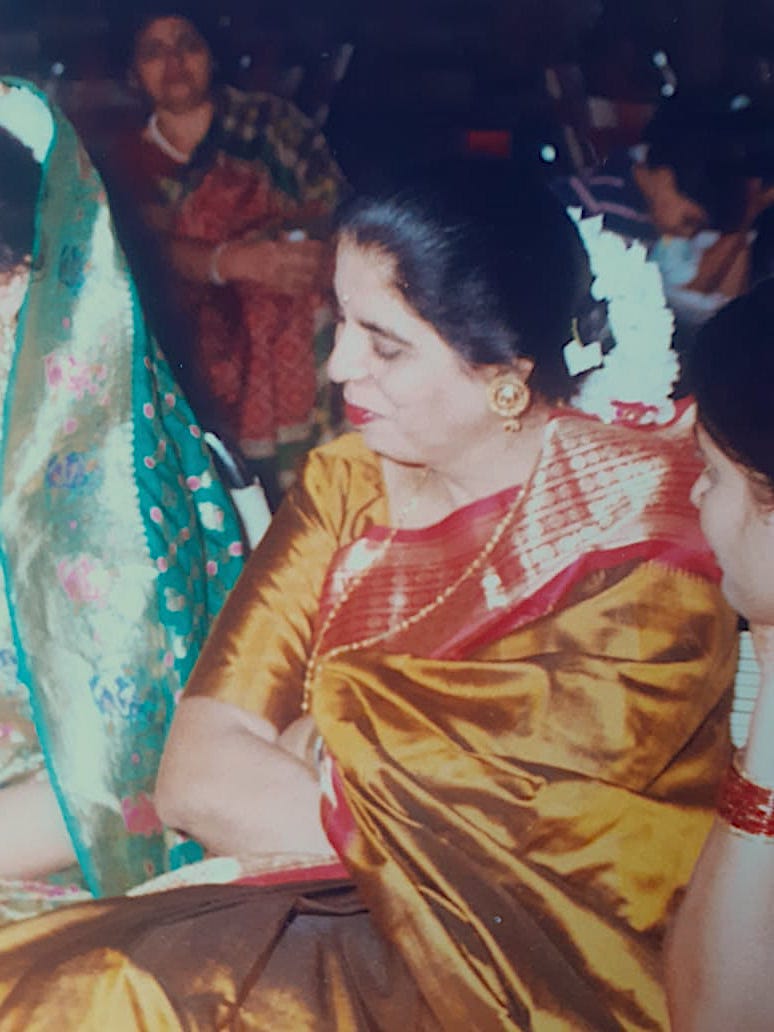An Intimate History of loneliness
Shatakshi Whorra
My grandmother passed away last year just after Lucknow summer had hit its peak. Even before grief and mourning could grip my mother, she was fazed by guilt. Perhaps if my mother’s onset of grief could have coincided with the arrival of monsoon, a certain plentitude of those torrential months making accommodations for her sadness — she would have mourned a little easier. There is something cathartic about the benevolence of seasonal showers as they envelope entire cities. Heavy laden clouds as they take over the horizon, the city briefly stops in its tracks and we let ourselves mimic nature. We turn inwards, make room for a silent, slow-moving surrender, and permit painful remembrance to take over us. It’s mostly true that “a good rain knows best when to fall.” I wish it would have been so for my mother.
Her mourning was anything but seamless. Her grief swelled in her chest, without any respite. Two years after Nani’s peaceful death, my mother’s self-condemnation has been unforgiving, she’d complain: if only I could have done more. My mother and grandmother had drifted five years prior to Nani’s death. Throughout this period of distance between them, my mother could not bring herself to offer genuine care to Nani, even when she was ailing. As the years passed, there was no reconciliation. When Nani passed away last year, it hit my mother— it was too late.

Nani at mom’s wedding. 26th October, 1990.
There is something oddly satisfying about guilt’s incredulous desire to self-flagellate. For my mother, I wonder if her self-inflicted emotional turmoil was the only repentance she could offer. Despite my countless attempts at consolation, her insistence upon her personal failing was relentless. I imagine guilt to be a pit from which escape is impossible and that is where my mother had suddenly found herself.
—
In the last couple of years before Nani passed away, she neither had any long-standing ailments nor excruciating physical pain that was debilitating her. Her pain was internal— it rose from something seemingly covert and therefore she along with her affliction often went unacknowledged and misrecognized. She took less and less space as time went by. My grandmother, Bela, didn’t say much, she didn’t move around much. In her stillness, she wasn’t ever grimacing nor seemed perfectly happy. Over the years Nani’s stalemate of emotions became characteristically her, her most identifiable trait now, she came to be infamously known for it. In the home, around Nani, this stagnating air of silence allowed her to be both present and absent.
For the last ten years every time I visited her, she was always seated on her wooden chair,
the kind you’d find in a classroom designated to a teacher that marks their authority. In her patriarchal home, however, there was very little space for Nani to assert her own needs. Her desires would always come second to that of her husbands’ and sons’. When we would talk about Nani, my mother very often expressed how scared she was of the men in the family and the callous dominance with which they had treated her. It’s no wonder that it was easier to become reticent than it was to claim her rightful place as an equal member in her marital home.
Nani’s stone-like existence could have easily been mistaken by an unaware guest for a peaceful state or a leisurely slouching, but it was in fact painfully lonely. The people who had known her, whether in the latter or former stint of her life, knew better. Even though there wasn’t any open acknowledgment, they had known that her slow-moving silence and her withdrawn demeanor could not be reduced to a temperamental flaw. My mother tells me about her grace and the manner in which she would carefully curate herself. These acts of care, towards her body, allowed her to express her individuality which faded as her husband and her sons’ needs took precedence. There was never a diagnosis, never a name to this eroding self. My grandmother was not merely suffering from pangs of loneliness. Her deterioration over the years was as personal as it was overwhelmingly systemic. I see this onset of loneliness in her life not as a personal failing, but as something that stemmed from the unequal relationships that had been slowly consuming her.
I started thinking about loneliness more deeply after devouring Olivia Laing’s collection of essays, The Lonely City in the summer of 2020. It was the perfect book to be read in the context of a surreal pandemic in which we had started to live; social isolation had become the only potential means to our survival. With Nani’s demise and the feeling of isolation that I had been experiencing in the pandemic, Laing theorization was a timely intervention.
—
Laing contends that loneliness invokes a pathological response in the other which isolates the lonely individual further. Freida Fromm-Reichmann, a German psychologist who is woven into her text, elaborates upon how isolating the experience of loneliness is in itself for the individual because of the inexplicability of the condition: “Nor, unlike other non-communicable emotional experiences, can it be shared via empathy. It may well be that the second person’s empathic abilities are obstructed by the anxiety-arousing quality of the mere emanations of the first person’s loneliness.” In an effort to avoid re-experiencing the pain of loneliness, Laing suggests that it becomes difficult to recollect what it felt like to be lonely in the first place. This state of loneliness is also often viewed as a “taboo state” that induces repulsion.
In thinking about how lonely my grandmother was, I found the resemblance between the onset of disease and loneliness to be revelatory. In ways similar to a disease that invites bias perhaps because of lack of awareness or that it was misjudged to only affect an already discriminated population, as was the case with AIDS in the US— loneliness too like an affliction “seems destined to cause others to turn and flee”. The immediate response in both cases is often repulsion. When I read this in Laing’s book, I realized that I too was guilty of this. I had kept a distance from Nani, and later even from the people that I had met in college, who seemed to be without friends. It had induced that desire to flee, to abandon their company. Admittedly, I feel ashamed of my unkindness, as Laing does too. But her reflection gave greater clarity as to why I remember always having felt that Nani was sick in the absence of actual disease. As a child, my grandmother’s self-imposed quarantine in her wooden chair and family distancing themselves from her resembled too much of a serious illness. And in doing so, everyone in the family eventually started to believe that Nani had some elusive disease that could never be diagnosed. This often aroused both pity and disgust that led to her being “separated” and “exposed” at the same time.
—
Loneliness is both ordinary and extraordinary an experience. Having affected almost everyone to some degree, it is befitting of a normal human experience. Yet, what makes it so compelling, so extraordinary is the incredulous demands it makes upon us. It invites shame, making admissions of it rather difficult. The chronic nature of the condition is that loneliness begets itself, reproducing in the body of the host. It latches onto feelings of shame and isolates the bearer further. When this is compounded with the prejudices of one’s caste, class, race, and gender, the isolation is crushing, a stigma that simply cannot be gotten over or dealt with as Laing rightly says by simply going on. Loneliness becomes purgatory, it seems inescapable.
Laing writes: after an experience of loneliness both the damaged individual and the healthy society work in concert to maintain separation. The more withdrawn Nani had become, the more severe her isolation became. Everyone around her who would both see yet unsee her became both witnesses and collaborators in her loneliness. Laing further claims in the context of artists who were dealing with crippling loneliness in their lifetimes, “You can’t think about people like Darger, or Solanas, for that matter, without thinking too about the damage society wreaks upon individuals: the role that structures like families and schools and governments play in any single person’s experience of isolation. It’s not only factually incorrect to assume mental illness can entirely explain Darger; it’s also morally wrong, an act of cruelty, as well as a misreading.”
Nani was married off when she was really young, seventeen, I think. My grandfather was demanding and dismissive of her needs. By the time the twilight years of her marriage had set upon her, she had become half the person she was. Stuck in a patriarchal setup, jostled between the needs of her husband and sons, her capacity to voice her displeasure stiffened, seriously affecting her mental health and inducing the subsequent onset of loneliness that came with her struggle. I wonder about her, whose state in her latter years was often justified with a statement, “Unko moh chhut gaya hai”, she has lost all her worldly desires. What would it have meant for her to have lost the desire for a favorite thing, for her dreams to slowly become vacant, for the skeleton of desire to pile up in the privacy of her closet? What did it mean for my grandmother to drown out her fantasies in the face of her wifely and motherly duties that left very little room for her, an erasure that signified a bigger loss— the lonely art of losing oneself. This is where she perhaps had found herself in her last days.
In the end, however, Nani had found an unlikely friendship in her nurse with whom she had forged the ritual of eating cut fruit together. Neatly cut slices of apple would be shared between them, one for nani, the other for nurse, till the plate was emptied of fruit and only stems and seeds would remain. Nani, who hardly spoke to anyone, had in the last years of her life experienced a lot of joy in this intimate exchange. My only hope is that it at last brought her solace and the companionship she had always craved for.
Works cited
Laing, Olivia. The Lonely City: Adventures in the Art of Being Alone. New York: Picador, 2016.
![]()

Shatakshi Whorra currently teaches English at Nirmal Bhartia School in Delhi. She enjoys working with students and creating an empathetic classroom so that young people can unapologetically learn to be themselves. She is actively working on her new year resolution of ‘read more, write more!’. As a writer, Shatakshi enjoys playing around with genres, mixing her poetry with her prose and vice-versa. She is based between Lucknow and Delhi. She has been previously published in Gulmohar Quarterly, Alipore Post and Feminism in India.



